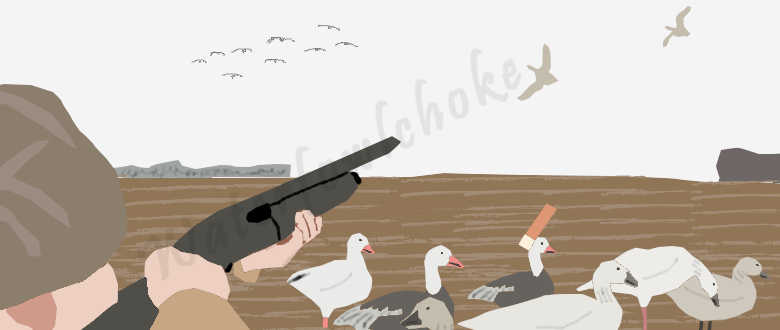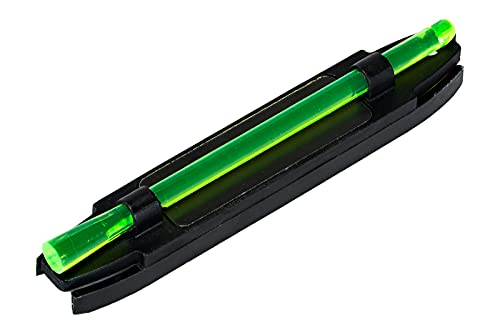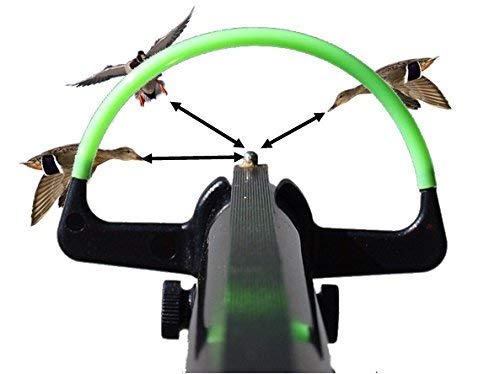↬ Missing shots on geese is frustrating, but can be corrected with a few simple tips.
When shooting geese you should always aim out in front of the bird so that it flies into the shot. This requires a 1-2ft lead when birds are within 40 yards. When aiming is done correctly, the pellets should hit the goose in the front part of the body which includes the head and neck.
Aiming in front takes into account the travel time of both the bird and shotgun pellets to reach the same spot at the exact same time. In this guide, we’ll discuss how to lead a goose in more detail and provide tips for being more accurate in the field.
![]()

Where do you aim when shooting geese?
Aiming while goose hunting is different than when duck hunting. Geese are slower moving birds and require less lead than ducks. A mistake some hunters make is overestimating the speed that geese fly and not judging the range correctly due to misperception of the size of the goose.
The best way to aim when goose hunting is to first familiarize yourself with what a 3-4lb goose looks like at the ranges you’ll be shooting. Practicing estimating range will help with shot placement in the field on moving birds. A premium choke tube capable of delivering tight patterns at long ranges is also high on the list.
SUMMARY
Always aim out infront of a goose so that pellets hit it in the head and neck. Most geese over decoys only require a 1-2ft lead. At longer ranges with birds flying faster, the lead you need could be 5ft or more. Taking a wide range of shots under real hunting conditions is the best way to learn where to aim when goose hunting.
How do you judge the range when goose hunting?
Judging the range of geese and ducks comes with experience, but there’s several tricks you can employ to make quick aiming calculations in the field. The first method is to place markers in the field at pre-determined distances, so you know when a goose reaches it what range they are at. Goose decoys make good range markers for this method.
The second method is to spend as much time in the field or sporting clay range as you can. Practice makes perfect and there’s nothing quite like trial and error in the field for mastering aiming. Laser range finders are a valuable tool to experiment with marking distances for geese on the wing or on the ground.
Related Products
How far should you lead a goose?
The distance you should lead a goose increases with range and flight speed of the bird. A 50-yard shot on a fast-moving goose may require a 3-4 foot lead (or more). Aiming should be done with your cheek on the stock of the gun and eyes on the bird. The bead should not even be a factor.
For decoying geese up close, a lead may not be needed at all. Geese feet down in the decoys require no lead. Backpedaling geese trying to get out of the spread require a very small lead or simply just aiming at the head.
Low light conditions are one of the situations where being able to see the shotgun bead is the biggest concern. This issue occurs right at shooting time and it can be difficult to sense where the end of the barrel is. Luckily fiber optic sights can be installed on most shotguns which make the bead light up. The HIVIZ magnetic sight snaps on to a vent rib for easy installation. Check it out so you don’t have to be frustrated aiming at shooting time.
 Tips for aiming when shooting geese
Tips for aiming when shooting geese
- Always aim in front of a moving bird. It’s better to miss in front than behind.
- A goose at 40 yards typically only requires a lead of 1-2 feet.
- Account for wind drift on breezy days. A stiff wind can cause shot to drift off target that would otherwise hit a bird on a calm day.
- No amount of aiming can make up for shots that exceed the effective range of the ammo.
- Judging the correct lead can only be improved with practice.
- Crossing shots on moving birds are the hardest shots to aim proficiently on.
- Improved shotgun sights can help with aiming, especially in low light conditions.
- Do not treat aiming on ducks the same as aiming on geese.
Goose Aiming FAQs
How far away can you shoot a goose?
The furthest away you can shoot a goose with a shotgun is debatable, but 100 yards is generally the max. At this range, it makes it difficult to hit a fast-moving bird and also judge the lead required. Additionally, shot drop at longer ranges may require aiming 5-10 feet higher than the bird is flying.
Longer shots like these are only capable with heavyweight and TSS waterfowl loads in shot sizes of #4, #2, or larger. These shot types are only able to achieve these results due to the dense tungsten they are made from.
Long distance shots on geese at max ranges are difficult to replicate since they require factoring in many different split-second calculations such as wind drift, lead times, and pellet drop. Shots at shorter ranges are always preferred since the chance of a clean harvest is greater and no one likes skybusters.
How far do you lead a goose at 40 yards?
A goose at 40 yards only needs a small lead of 1-2 feet. While this is only an estimate since there are many other factors to consider, leading a goose too much isn’t a bad thing, since shooting behind them will never be successful.
Wind speed and how fast the goose is flying are key aspects to consider when determining the correct lead. Fast flying geese will need 2-3 feet of lead or more at 40 yards, while decoying birds head on will require no lead at all.
As with most shooting sports, practice makes perfect, and keeping shotshell speed and your shotgun the same over a period of time can help dial in the correct lead. Changing loads or guns and never developing a comfortable setup can lead to questioning how much to lead a bird, when the optimal process should rely on split second instinct and muscle memory.
What’s the best choke for goose hunting?
The best goose hunting chokes are extended chokes that are ported and offer tighter diameters that work well with all shot types. These types of chokes can hold patterns together at longer ranges and give added knock down power.
If you want an affordable, versatile waterfowl choke tube – that can deliver tight patterns at longer ranges – look for a ported choke tube that costs around $80. It will work well with most shotguns while hunting over decoys or for passing shots. (The Patternmaster Code Black has been our favorite for this style for many years). Check it out, you won’t be disappointed.
What size shot is best for goose hunting?
The best shot size for geese is BBB. BBB shot retains enough energy to cleanly harvest geese at up to 67 yards. This range might not sound like much but can be considerable when it counts for skittish geese on the edge of the decoys.
If you hunt geese exclusively, the knock down power and added range of BBB shot cannot be matched by smaller pellets such as BB (see the BB vs BB comparison). Real world field applications prove this to be true. BBB shot is ballistically superior and with larger birds such as geese, you need all the help you can get.
For late season decoying where geese are skirting the decoys or pass shooting scenarios, BBB is the clear winner for goose hunting. For early season birds feet down in the decoys or conservation snow goose order, dropping pellet sizes to as small as #2’s can be viable.
Bottom Line: Aim for the Head and Neck
You should always shoot in front of a goose when aiming. This lead accounts for the speed of bird in flight as well as the time it takes the pellets to travel the distance. Decoying geese may require no lead at all, while fast moving passing birds can require 3-4 feet of lead or more. 1 to 2 foot of lead is usually enough for most shots on geese within 40 yards over decoys.
When aiming for geese, always do so with the intention of hitting the bird in the head or neck. This gives the best chance for a clean harvest. If you always aim out front of the bird, you’ll always have the chance of hitting. As opposed to missing behind, which never has a chance in the first place. The key to clean harvests is a good patterning choke tube that works well with the ammo you are using.
Was this helpful?
![]()
Search Chokes by Gauge
Related
- The Ultimate Shotgun Pellet Size Chart
- Pellet Count Chart Per Ounce
- TSS Pellet Count Chart – Per Ounce
- Buckshot Pellet Count Chart
- TSS Pellet Weight Chart
- Choke Tube Effective Ranges for Waterfowl
- Effective Range of TSS for Turkey Hunting
Latest Posts
- Best Waterfowl Choke Tubes for 2024, Expert Picks

- Choke Tube Diameter and Constriction Table

- 5 Easy Ways to Remove a Stuck Choke Tube

Last update on 2025-11-24 / Affiliate links / Product Images from Amazon Product Advertising API






